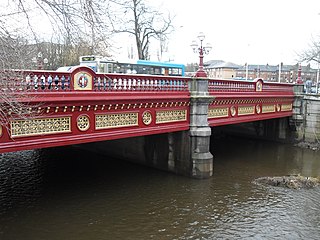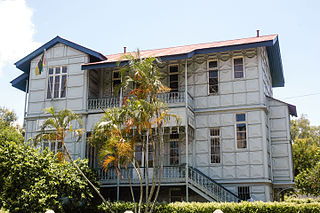
A pier is a raised structure that rises above a body of water and usually juts out from its shore, typically supported by piles or pillars, and provides above-water access to offshore areas. Frequent pier uses include fishing, boat docking and access for both passengers and cargo, and oceanside recreation. Bridges, buildings, and walkways may all be supported by architectural piers. Their open structure allows tides and currents to flow relatively unhindered, whereas the more solid foundations of a quay or the closely spaced piles of a wharf can act as a breakwater, and are consequently more liable to silting. Piers can range in size and complexity from a simple lightweight wooden structure to major structures extended over 1,600 m (5,200 ft). In American English, a pier may be synonymous with a dock.

Alexandra Park is a public park in the East End of Glasgow, Scotland. It is located in Dennistoun, 2 miles (3 km) east of the city centre. Named after Princess Alexandra of Denmark, it opened in 1870. The highest point of the park gives views north to Ben Lomond and south to the Tinto Hills. The park is generally open from dawn to dusk daily, but the facilities inside the park have separate opening and closing times accordingly.

Glasgow Botanic Gardens is a botanical garden located in the West End of Glasgow, Scotland. It features several glasshouses, the most notable of which is the Kibble Palace.

James Salmon (1805-1888) was a Scottish architect, active chiefly in Glasgow and the west of Scotland.

Dennistoun is a mostly residential district in Glasgow, Scotland, located north of the River Clyde and in the city's east end, about 1+1⁄4 miles east of the city centre. Since 2017 it has formed the core of a Dennistoun ward under Glasgow City Council, having previously been a component of the East Centre ward.

Possilpark, colloquially known as Possil, is a district in the Scottish city of Glasgow, situated north of the River Clyde and centred around Saracen Street. The area developed around Saracen Foundry of Walter MacFarlane & Co., which was the main employer. In the wake of the Saracen Foundry's closure in 1967, this part of Glasgow became one of the poorest in the United Kingdom, and decades later deprivation and crime rates remain high.

Llandudno Pier is a Grade II* listed pier in the seaside resort of Llandudno, North Wales, United Kingdom. At 2,295 feet (700 m), the pier is the longest in Wales and the fifth longest in England and Wales. In 2005, was voted "Pier of the Year 2005" by the members of the National Piers Society.

Cast-iron architecture is the use of cast iron in buildings and objects, ranging from bridges and markets to warehouses, balconies and fences. Refinements developed during the Industrial Revolution in the late 18th century made cast iron relatively cheap and suitable for a range of uses, and by the mid-19th century it was common as a structural material, and particularly for elaborately patterned architectural elements such as fences and balconies, until it fell out of fashion after 1900 as a decorative material, and was replaced by modern steel and concrete for structural purposes.

Victoria Leeds is a shopping district and leisure area in central Leeds, comprising the 1990 Victoria Quarter, an arcaded complex of restored 19th-century and contemporary shopping arcades, and the 2016 Victoria Gate development. Notable for its role in the regeneration of Leeds' city centre, and a programme of restoration and reuse which included commissioning the largest work of stained glass work in Europe, designed by artist Brian Clarke, to cover the newly pedestrianised Queen Victoria Street, the 1990 scheme created a covered retail district of linked arcades. In 2016, the Victoria Quarter was merged with the newly built Victoria Gate complex to form the largest premium retail and leisure venue in Northern England. The district includes a casino and major stores such as Harvey Nichols and John Lewis and Partners.

The Saracen Foundry was the better-known name for the Possilpark, Glasgow-based foundry company W MacFarlane & Co. Ltd, founded and owned by Walter MacFarlane. MacFarlane's was the most important manufacturer of ornamental ironwork in Scotland.

22 Park Circus is a 19th-century townhouse in the West End of Glasgow, Scotland. Originally a family home, it was later a club and an Italian consulate. From 1994 to 2013 the building housed the city's register office.

The Glasgow International Exhibition was the second of 4 international exhibitions held in Glasgow, Scotland during the late 19th and early 20th centuries. The exhibition took place during a period of half-mourning requested by Edward VII but was still popular and made more than £35000 profit. The exhibition was opened by the King's daughter, the Princess Louise, Duchess of Fife.

A pissoir is a French invention, common in Europe, that provides a urinal in public space with a lightweight structure. The availability of pissoirs aims to reduce urination onto buildings, sidewalks, or streets. They can be freestanding and without screening, with partial screening, or fully enclosed.
An iron founder in its more general sense is a worker in molten ferrous metal, generally working within an iron foundry. However, the term 'iron founder' is usually reserved for the owner or manager of an iron foundry, a person also known in Victorian England as a 'master'. Workers in a foundry are generically described as 'foundrymen'; however, the various craftsmen working in foundries, such as moulders and pattern makers, are often referred to by their specific trades.

Dolphin lamp standards provide electric light along much of the Thames Embankment in London, United Kingdom. Two stylised dolphins or sturgeons writhe around the base of a standard lamp post, supporting a fluted column bearing electric lights in an opaque white globe, topped by a metal crown. Many of the lamps are mounted on granite plinths.

Rondebosch Fountain is an ornamental Victorian drinking trough for horses, standing on a traffic island on the intersection between Belmont Road and Main Road in the centre of Rondebosch in Cape Town, South Africa. It was declared a National Monument on 10 April 1964.

Abbey Bridge is grade B listed road-bridge over the White Cart Water in the centre of Paisley in Scotland. It was erected in 1879, widened in 1933, and comprehensively restored in 2009.

The Springburn Winter Gardens is a former large winter garden located at Springburn Park in the Springburn district of the Scottish city of Glasgow, constructed in 1900. The building was damaged in a storm and fell out of use in 1983 but was saved from planned demolition on 22 March 1985, when the Scottish Office included the structure on the Statutory List of Buildings of Special Architectural or Historic Interest, at category A.

The Casa de Ferro is a historic prefabricated iron building located in Maputo, Mozambique. Originally built in Belgium, the structure was bought by the Portuguese colonial government and reassembled in 1892 in Maputo. It was intended to serve as the residence of the Governor of the District of Lourenço Marques.
Paul Dobraszczyk is a British writer and academic whose work addresses architecture, as well as a photographer and visual artist.




















